DISTURBED, possessed, infected, supernaturally influenced or preternaturally gifted, the children of this month’s brood are only slightly more terrifying than the roaming packs of precocious preschoolers on Manhattan’s Upper West Side. Kids can be terrifying with their ignorance of societal mores, often reduced to fits of id. Ever seen one in a rage at the park? Ever sat behind that kid on a plane? Ever watched a helpless mother try to calm the kid down? Now imagine that kid with an arsenal of weapons both real and telepathic…
Strange kids didn’t appear suddenly one morning in Hollywood after The Sixth Sense. No, you can follow a trail of breadcrumbs, laid out long before Shyamalan’s hit, from past to the present. The Innocents (1961), It’s Alive (1974), The Godsend (1980), Firestarter (1984), Pet Sematary (1989), The Good Son (1993), The Others (2001), The Orphanage (2007), Case 39 (2009) all feature tots with special powers for good or for evil. There are, to be sure, hundreds more but this isn’t a comprehensive list. It’s only a taste of the films I watched this month. I’ve listed the best along with, in some cases, lesser counterparts or terrible remakes.
I’ll start with Village of the Damned because it sets the scene so wickedly. The rest of the list goes in order from least favorite to most enjoyably beastly.
~~~
Village of the Damned (1960 & 1995) – While The Bad Seed (1956) may be the mother of murderous brat flicks, 1960’s Village of the Damned (based on a 1957 novel, The Midwich Cuckoos, by John Wyndham) redoubles the population of homicidal tykes to catastrophic numbers. Like The Day of the Triffids, this one pits humanity against forces powerful enough to destroy society as we know it. It’s a mutation just close enough to home to make its elaborate science fiction plausible; certain varieties of the cuckoo bird lay their eggs among nests of other species, with their young being raised in a sort of accidental adoption… Start there.
When the entire population of Midwich falls into a temporary coma, the citizens awake to find every woman of childbearing age pregnant. The fetuses develop rapidly and are given birth on the same day at the same time: a bounty of blond, blue-eyed tykes with telepathic gifts that can turn deadly.
Spoiled infants might toss their peas but a Midwich kid will control your mind with fatal results if you don’t give him an extra piece of candy. As groups of strange beings are wont to do in stories like this, the Children may or may not want to take over the world but, soon enough, are making demands that they be sent to a secure location to avoid threats from the international forces that fear them.
In the original black and white version, the great George Sanders (All About Eve, The Picture of Dorian Gray), as local, village professor Gordon Zellaby, establishes a trust with the hive-mind children, secretly helping facilitate a plan to stop them. Aside from a bit of dated creakiness, there isn’t much to criticize in this film. Sanders plays it straight and the antagonistic children are well cast. (Their performances are superior to those in John Carpenter’s accidentally funny 1995 remake.) Martin Stephens, who plays an equally strange child in 1961’s The Innocents, is remarkable here as the group leader. The film builds dread toward the terrific final frames which, despite some old-fashioned special effects, are chilling.
John Carpenter would seem the perfect director to remake this classic but his version never generates the atmosphere so beautifully drawn in his best work. With the children supremely miscast and poorly directed to “act evil,” there is no sense of menace, just empty line readings of rotten dialogue like, “You will bring us supplies,” and “You still do not know who – WHAT – we are.” The fault lies with Carpenter, who substitutes random acts of violence for character and suspense. You get to watch Kirstie Alley give herself an appendectomy. Christopher Reeve takes the George Sanders role. Alley is good and Reeve says his lines but Carpenter’s remake left me feeling a battle between these two gangs would see his tykes buried by the original Midwich moppets.
~~~
Orphan (2009) is a diverting thriller on a familiar subject: strange child affects troubled nuclear family. Vera Farmiga does well in a role similar to her previous hysterical mother in Joshua (a similar but inferior film). The rest of the cast, including Peter Sarsgaard, Margo Martindale, C.C.H. Pounder and especially Isabelle Fuhrman as the mysterious Esther contribute excellent work under the careful direction of Jaume Collet-Serra, whose previous House Of Wax is almost entirely forgettable. The other two children, as Esthers adoptive siblings (Aryana Engineer and Jimmy Bennett), also give terrific performances.
This film doesn’t generate as much suspense as Paranormal Activity, nor does it have the biblical layers of The Omen but a fine screenplay and direction help Orphan overcome its sense of familiarity. Its unique plot twist strains credibility but Little Miss Fuhrman gives such an extraordinary performance you’ll find yourself as terrified of Esther as everyone else.
~~~
The Children (2008) is no relation to The Children (1980) and, except for the title and this month’s theme, has no family resemblance. Together with Who Can Kill a Child? and Children of the Corn, these four films are like the results of some reality-show contest asking filmmakers to shoot a movie about gangs of killer kids. Rule #1: you must use a variant of “child” in the title.
Between The Children and The Children, The Children is the more successful of the two. That is, The Children: 2008. Two families come together for the Christmas holiday. Then the kids start acting weird. They each get ill in turn before turning loony. Of course, we find out early on it’s something in the blood – a virus or a bacteria (natch)– that turns these kids into juvenile delinquents though the adults are quick to blame each other’s bad parenting. Just like adults, isn’t it, to blame the parents for their kids’ horrible behavior? Acting more like kids than the kids themselves, the adults go at each other, raising the level of paranoia until they discover their offspring haven’t been spoiled by indulgence but have spoiled like rotten fruit. By then it’s too late; the parents go running for their lives, hiding in closets, and stabbing kids with shards of broken glass.
The acting is excellent and the characters often follow Rule #2: do the dumb horror movie thing. In other words, the exact opposite of what you should do to save yourself. Still, it’s a tense movie, with everyone helplessly snowbound and the parents in deep denial that theirs would ever be the bully – or the killer – on the block.
The 1980 film, distributed by Troma Films (The Toxic Avenger, Mother’s Day), isn’t nearly as successful though it’s made with some care. Unlike most Troma releases, this one was distributed under the Troma label but written and produced by someone else (Carlton J. Albright) which may be why it’s (only slightly) better than schlock.
The formula here is school bus + toxic cloud = savage squirts. The cloud turns the small fry into mini-microwaves, giving them the ability to cook anyone they touch – even through denim. We know they’re dangerous because of their black fingernails. Bad special effects aside, the actors do their best to make it work. It’s dated and not terribly scary, though as a kid I was terrified of the whole thing. I’d avoid it unless you’ve got some kernels that need quick popping.
~~~
Who Can Kill a Child? (1976) & Children of the Corn (1984) – Narciso Ibáñez Serrador’s 1976 thriller and Stephen King’s short story adaptation (filmed in 1984) share more than a few traits, but where King’s tale points to religious mania, Serrador’s film (based on the Spanish novel, The Children’s Game) leaves the origins of the violence ambiguous. The flabby film of King’s potent story doesn’t compare to its 1976 cousin.
In Serrador’s film, an English couple travel to sunny Spain for one final fling before the arrival of their child. Evelyn is pregnant with their first and both she and husband Tom are determined to enjoyed life before the due date. They find themselves on an island almost completely devoid of adults. On this island paradise, there is something wrong with the children. Cue sharp weapons.
Serrador’s delicately-paced creeper begins to pick up speed and anxiety as the couple seeks escape. It’s spare but tense, with limited special effects and almost no gore. (Come Out and Play, the poorly-received remake from March of this year, is available at Netflix On Demand, but you’ll find the original potent and powerful stuff.)
The original film version of Children of the Corn, on the other hand, is savage but colorless. It nonetheless inspired seven sequels (mostly of which went straight to video) and fails on too many levels, lacking even a kernel of atmosphere. (You’ll notice a running theme with me: real atmosphere is hard to come by and the Hollywood remakes of favorite horror films of the 70’s and 80’s have resulted in a homogenous wash of green to replace skill.)
In King’s story, a couple attempts to salvage their failing marriage but get some pretty bizarre counseling when they have to save each other from the clutches of a town full of sinister children. I’m beginning to believe the kids from Serrador’s grimy thriller left their Island of the Damned (as that film is also known) for the farming community in King’s Children of the Corn…
Like Pet Sematary which followed four years later and also features a bloodthirsty babe, Children of the Corn is filmed with a kind of television flatness that deprives it of excitement in spite of the scythes, pitchforks and meat slicers which threaten everyone over 18.
The object of worship and fear,“He Who Walks Behind the Rows,” never actually walks but instead, travels like a motorized bump under a shag carpet. I kept wondering if he was related to the sandworms of Dune. Whether a film sticks to the plot of its source material is less important than if the film is effective in its own right. Children of the Corn captures neither the desolation nor the mounting dread of the original King story. Even Linda Hamilton can’t help this lackluster film.
~~~
The Little Girl Who Lives Down the Lane (1976) is an eerie chamber mystery with excellent performances from Jodie Foster, Martin Sheen and Alexis Smith (in a vinegary cameo.) But don’t expect gore or shocks. This film, with its menacing title, is more a drama with a ghoulish heart.
 Rynn (Foster) is a 13-year-old girl whose father is strangely absent from the house they have rented from Mrs. Hallet (Smith). When Hallet and her son (Sheen) come calling on separate occasions, Rynn’s carefully-constructed life raises questions. A fortuitous accident leaves Rynn to pick up the pieces and we hope Rynn can dig herself out of a mess. With nearly all the action taking place inside the house and a cast of broadly drawn characters, this film feels more like a stage thriller but its sheer creepiness is given its due through young Foster’s mature performance (in spite of her absolutely terrible wig).
Rynn (Foster) is a 13-year-old girl whose father is strangely absent from the house they have rented from Mrs. Hallet (Smith). When Hallet and her son (Sheen) come calling on separate occasions, Rynn’s carefully-constructed life raises questions. A fortuitous accident leaves Rynn to pick up the pieces and we hope Rynn can dig herself out of a mess. With nearly all the action taking place inside the house and a cast of broadly drawn characters, this film feels more like a stage thriller but its sheer creepiness is given its due through young Foster’s mature performance (in spite of her absolutely terrible wig).
One rotten moment involving an unrealistic disguise almost spoils the flat realism which makes the film so interesting. A bad 70’s soundtrack is also a poor juxtaposition to the Chopin concerto used throughout. Nonetheless, you will find yourself rooting for the deaths of certain characters even when you know you should know better. This is a little-seen gem that deserves your time.
~~~
The Omen (1976) – The wild success of The Exorcist in 1973 spawned a mess of terrible imitations but this big studio hit proved there was still a market for religious horror. The former explored themes of doubt and faith, but The Omen added mythological weight making it at once grander and more grandiose.
Directed by Richard Donner and boasting an impressive cast including Gregory Peck, Lee Remick, David Warner and Billie Whitelaw, The Omen suffers a bit from what Stephen King calls the limited shelf-life of horror. There have been enough religious-themed films since its release that its threat of Armageddon has become familiar. Even if, at this point, The Omen is more entertaining than frightening, it is still worth your time.
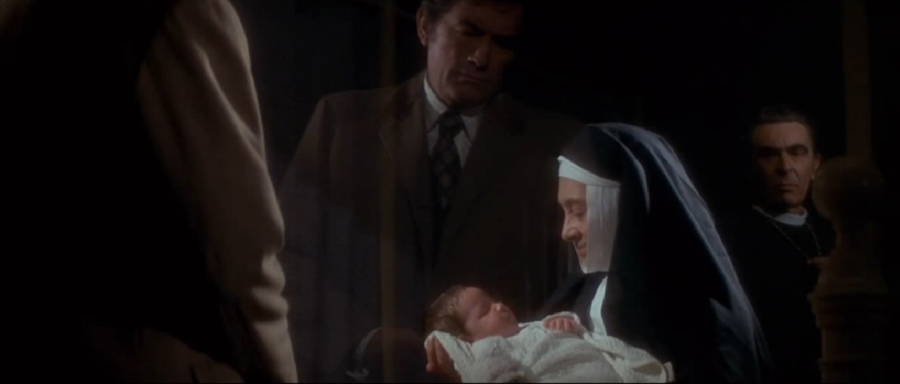
Robert Thorn (Gregory Peck) gazes on his newly chosen son as Father Spiletto (Martin Benson) approves.
The story is simple: Robert and Katherine Thorn (Peck and Remick), an American diplomat and his wife living in Rome, lose their firstborn son in childbirth. The monsignor at the hospital urges Robert to secretly adopt another boy whose mother has died at the same time. Robert accepts, reluctantly, fearing for his wife’s mental health. I don’t think I’m spoiling anything by telling you the kid ain’t right:his birth is the worst thing that could happen to the planet.
There’s a spectacularly violent hanging – at little Damien’s fifth birthday party. His nanny, noose around her neck, jumps to her death crying, “I love you, Damien! It’s all for you!” Things get worse from there, with freak accidents growing more and more violent. Eventually, Thorn is forced to admit that Damien’s origins may be something sinister.
The Omen has been praised as one of the best horror films of the 70’s and ranks high among religious and supernatural thrillers. A smart screenplay combines epic threat with violent shocks culminating in one infamous beheading. (Where and to whom this happens I will leave for those who haven’t seen the film. Let’s just say Gregory Peck, fine actor that he was, gives one of the best reactions in the film.) The Omen has enough to satisfy every kind of horror fan. The body count is high and the plot is compelling but what makes the film soar are the performances, high-grade technical aspects and the outstanding Jerry Goldsmith score laying on the apocalyptic doom.
The remake, which closely follows the original, boasts a sinister performance by Mia Farrow as the replacement nanny (originally played by the superb Billie Whitelaw, known for her long collaboration with Samuel Beckett). It doesn’t live up to its predecessor. Unfortunately, with horror remakes, this seems to be a running theme: no atmosphere, no tension, no surprise despite the overuse of jump scares and violently noisy soundtracks.
~~~
The Other (1972) is my favorite film this month.
Director Richard Mulligan takes his time with the opening shot, a long, panoramic view of a pastoral countryside which eventually focuses down to an unsettling shot of young Niles with his gaze fixed on something in his hands. As the camera draws near, we see what Niles sees: a ring on his finger bearing a peregrine falcon. When his twin brother, Holland (older by twenty minutes) happens upon him in the clearing, Niles quickly hides the ring in a tin box, later revealed as the hiding spot for another precious but gruesome treasure.
Very soon, terrible things begin to happen. Holland kills a pet rat for no apparent reason. The twins’ cousin is impaled on a pitchfork after discovering Niles in the forbidden apple cellar where the boys’ father was killed. When the twins are scolded by a neighbor and forced to apologize, Holland plays a nasty trick with an inadvertently fatal climax. The film gets weirder when Niles insists that his grandmother, Ada, play “The Great Game” with him – a game in which Niles can psychically inhabit other creatures. Later, the boys’ mother discovers the contents of the secret tin box and is severely punished by Holland…
This is an excellent film with an interesting set of secondary characters and a secret more emotionally complicated than the mechanics of the twist on which it hinges. For director Mulligan and author of the original novel, Thomas Tryon (also responsible for the excellent novel Harvest Home), the idyllic setting is merely a hiding place for horror. The Other is a compelling read and the film captures its nuances.
There’s high-grade acting from theatre guru and master-teacher Uta Hagan in one of her few film performances. As Ada, she carries the burden of the film’s emotional weight. There are also excellent turns by Victor French as farmhand Mr. Angelini, the lovely Diana Muldaur as the boys’ mother and a young John Ritter as the boys’ brother-in-law. This is one of those shivery thrillers which reminds me that gore cannot substitute for atmosphere, character and story-telling.
Glowing eyes also help.

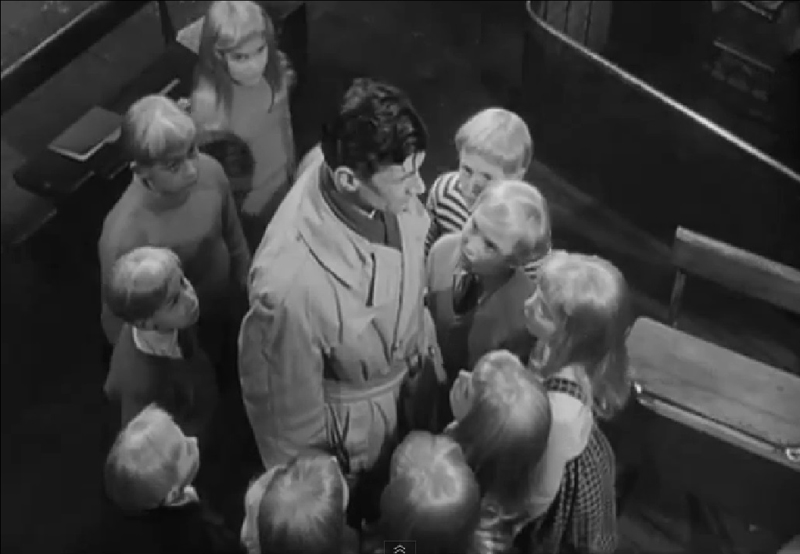
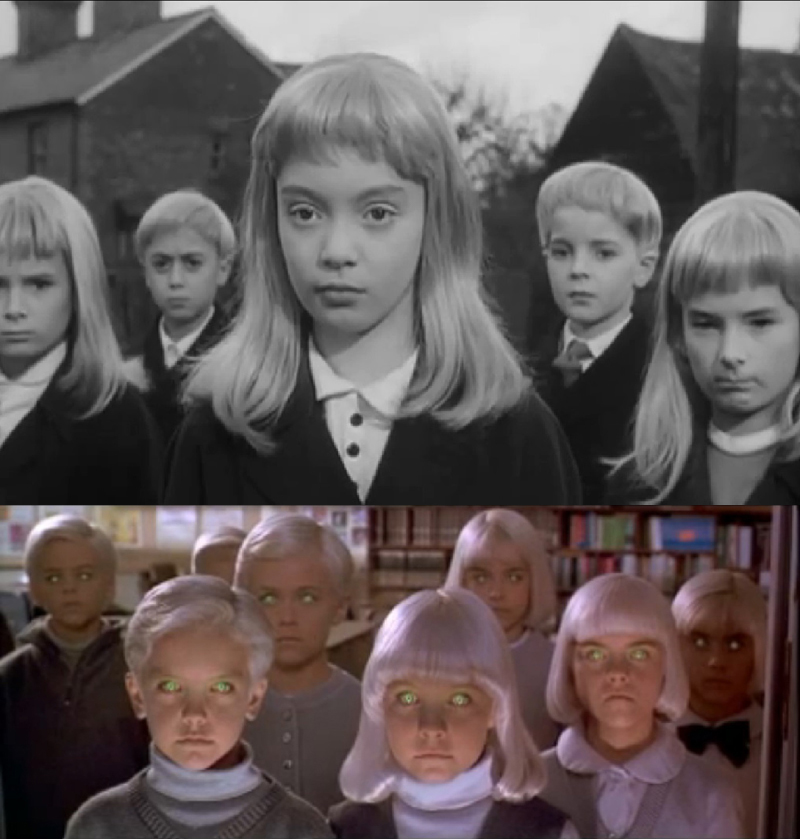
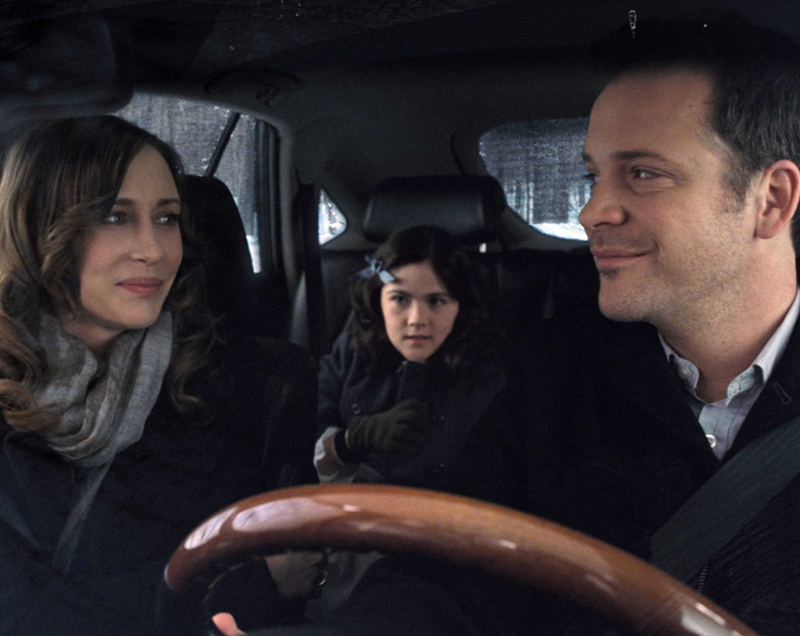
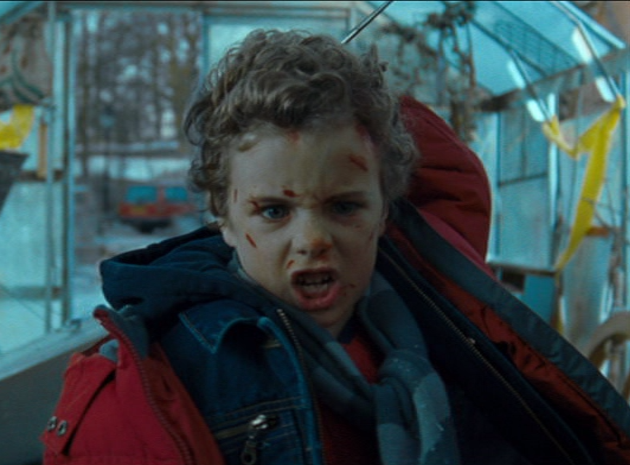
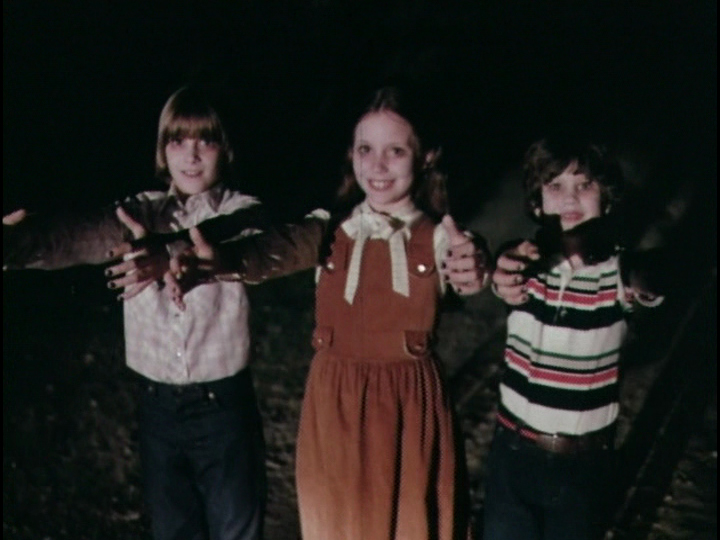
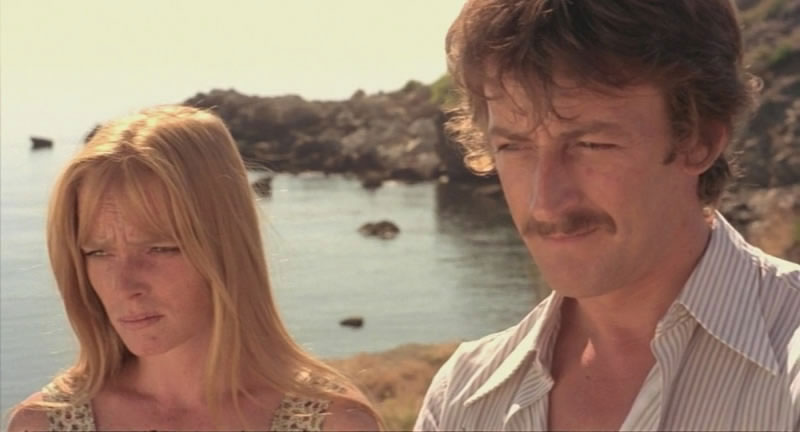
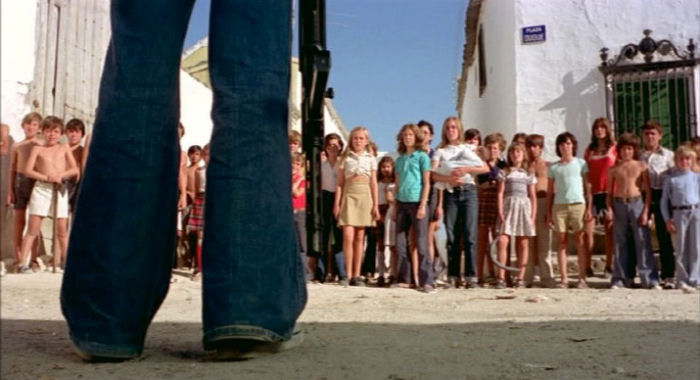
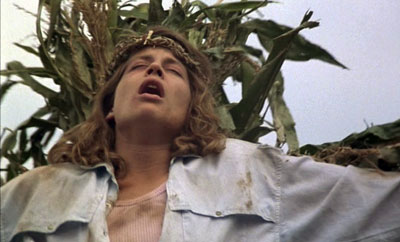

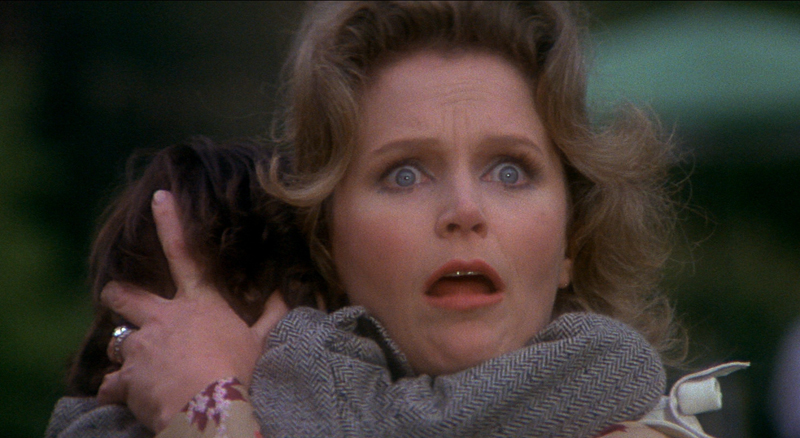
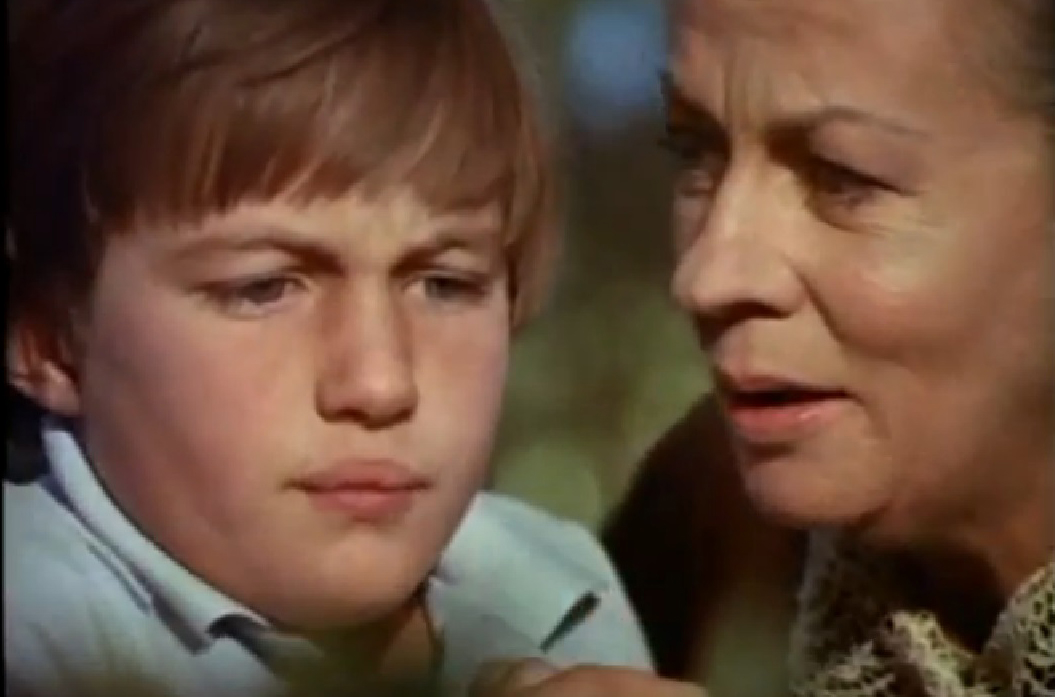
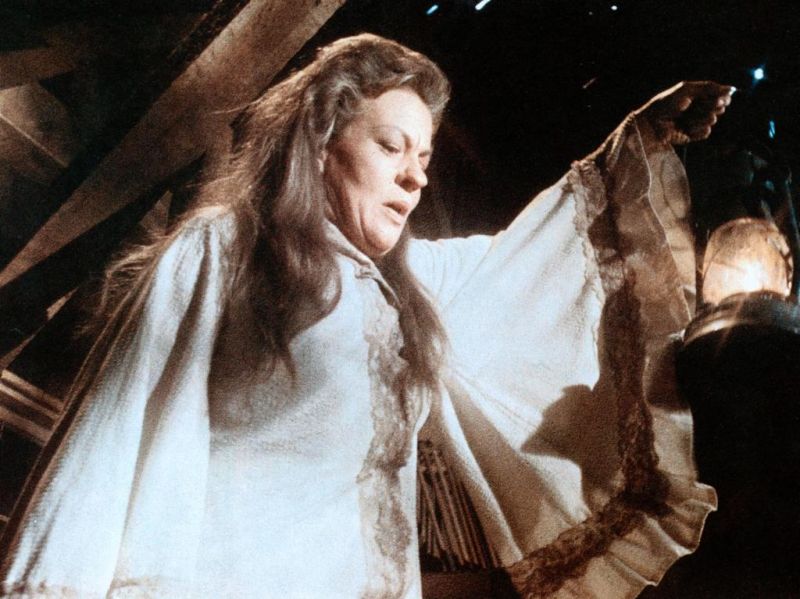
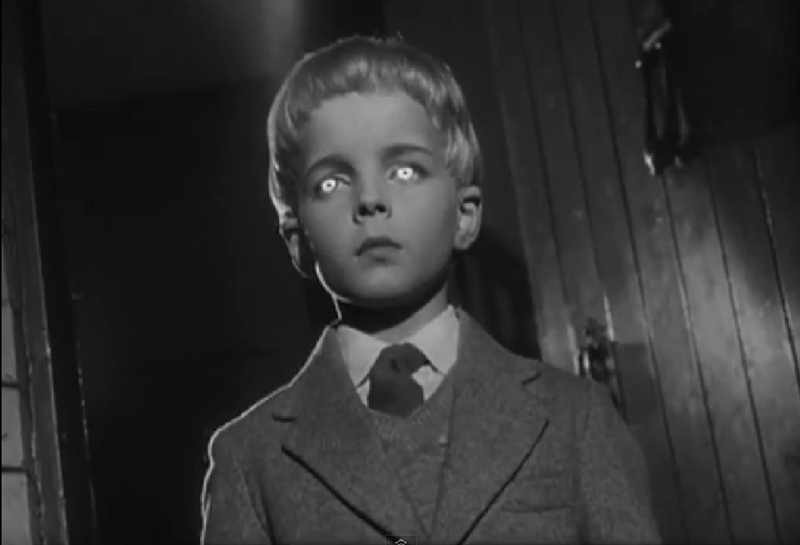


The Omen! I haven’t thought of that movie in years. It came out when I was a junior in high school. The reaction to the beheading scene – we imitated it often whenever we were pretending to be horrified. The looking away. The covering of the eyes. The fingers pushing through the hair. The dramatic grimace.
And the book that was the inspiration for The Little Girl Who Lives Down the Lane was excellent. I still remember it – which is pretty good for 40 years ago.